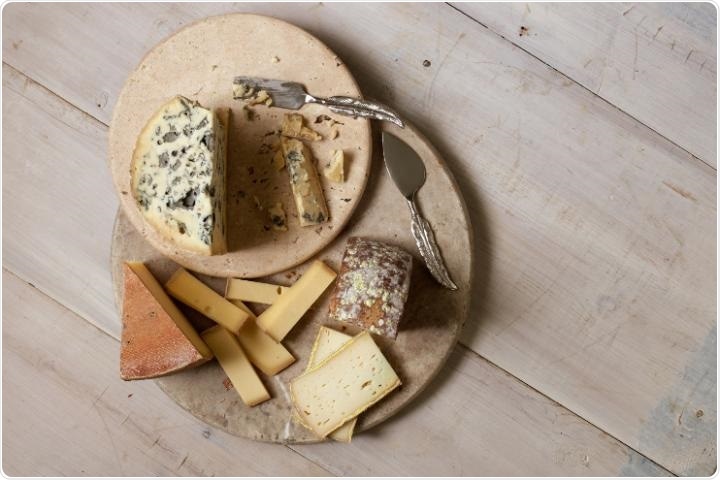Tufts University scientists have discovered that fungi use many ways to interact with bacteria and one of these methods is through the funky smells emitted by cheese. And the claims made by the researchers have plenty to do with the delicious range of flavors offered by cheese.

Fungi and bacteria key to ripening cheese communicate with and feed each other using volatile compounds. Image Credit: Adam Detour.
The team discovered that common bacteria crucial for ripening cheese ripening can detect and react to compounds synthesized by fungi in the rind and discharged into the air, increasing the growth of certain species of bacteria over others.
The composition of yeast, bacteria, and fungi that constitute the cheese microbiome is crucial to the quality and flavor of the cheese, so a better understanding of how that can be altered or controlled adds science to the art of cheese making.
Published in the Environmental Microbiology journal, the discovery also offers a model for the interpretation and modification of other clinically and economically significant microbiomes, like in the gastrointestinal tract or soil.
Humans have appreciated the diverse aromas of cheeses for hundreds of years, but how these aromas impact the biology of the cheese microbiome had not been studied. Our latest findings show that cheese microbes can use these aromas to dramatically change their biology, and the findings’ importance extends beyond cheese making to other fields as well.”
Benjamin Wolfe, Study Corresponding Author and Professor of Biology, School of Arts and Science, Tufts University
Several microbes synthesize airborne chemical compounds known as volatile organic compounds, or VOCs, as they communicate with their surroundings. Geosmin is an intensively recognized microbial VOC, which is produced by soil microbes and can usually be smelled after a heavy rain in forests.
Since fungi and bacteria thrive on ripening cheeses, both of them release enzymes that disintegrate amino acids to form alcohols, acids, amines, aldehydes, and numerous sulfur compounds, while other enzymes disintegrate fatty acids to create methyl ketones, esters, and secondary alcohols. All these biological products play a role in the aroma and flavor of cheese and they are the reason why Limburger Blue cheese, and Camembert have their signature smells.
The team from Tufts University observed that VOCs not only contribute to the sensory experience of cheese but also offer a method for fungi to interact with and “feed” bacteria in the cheese microbiome. By coupling 16 different common cheese bacteria with five common cheese rind fungi, the team found that the fungi caused responses in the bacteria, spanning from strong inhibition to strong stimulation.
Vibrio casei is one bacteria species that responded by growing quickly in the presence of VOCs produced by all of the five fungi. Other bacteria species, like Psychrobacter, merely grew in response to one of the fungi called Galactomyces, and two common cheese bacteria reduced considerably in number upon exposure to VOCs synthesized by Galactomyces.
The team found that the VOCs modified the expression of several genes in the bacteria, such as genes, that impact the way they metabolize nutrients. Glyoxylate shunt was one of the metabolic mechanisms that was improved and permits the bacteria to use more simple compounds as “food” when more complex sources, like glucose, are not available. In fact, they allowed the bacteria to better “eat” certain VOCs and employ them as sources for growth and energy.
The bacteria are able to actually eat what we perceive as smells. That’s important because the cheese itself provides little in the way of easily metabolized sugars such as glucose. With VOCs, the fungi are really providing a useful assist to the bacteria to help them thrive.”
Casey Cosetta, Study First Author and Post-doctoral Scholar, Department of Biology, Tufts University
Globally, the study has direct implications for cheese producers. When individuals walk into a cheese cave, they will observe that several VOCs are discharged into the atmosphere as the cheeses age. Such VOCs may affect how adjacent cheeses develop by inhibiting or promoting the development of particular microbes, or by varying how the bacteria generate other biological products that add to the flavor.
A deeper insight into this process could allow cheese producers to exploit the VOC environment to enhance the variety and quality of flavors. The implications of the study can be extended relatively more.
Now that we know that airborne chemicals can control the composition of microbiomes, we can start to think about how to control the composition of other microbiomes, for example in agriculture to improve soil quality and crop production and in medicine to help manage diseases affected by the hundreds of species of bacteria in the body.”
Benjamin Wolfe, Study Corresponding Author and Professor of Biology, School of Arts and Science, Tufts University
Source:
Journal reference:
Cosetta, C. M., et al. (2020) Fungal volatiles mediate cheese rind microbiome assembly. Environmental Microbiology. doi.org/10.1111/1462-2920.15223.